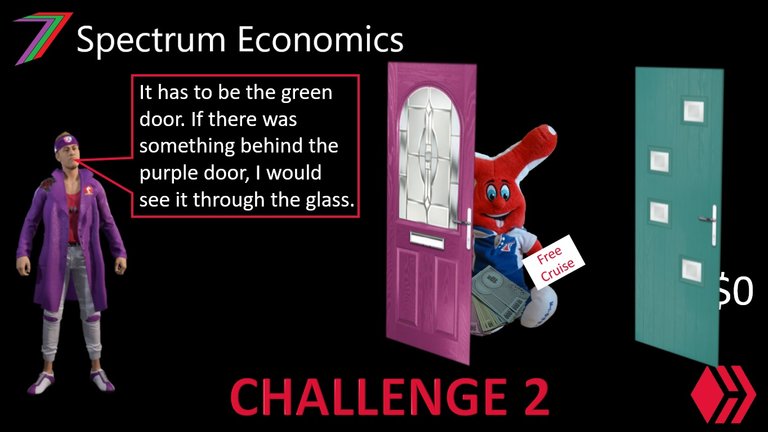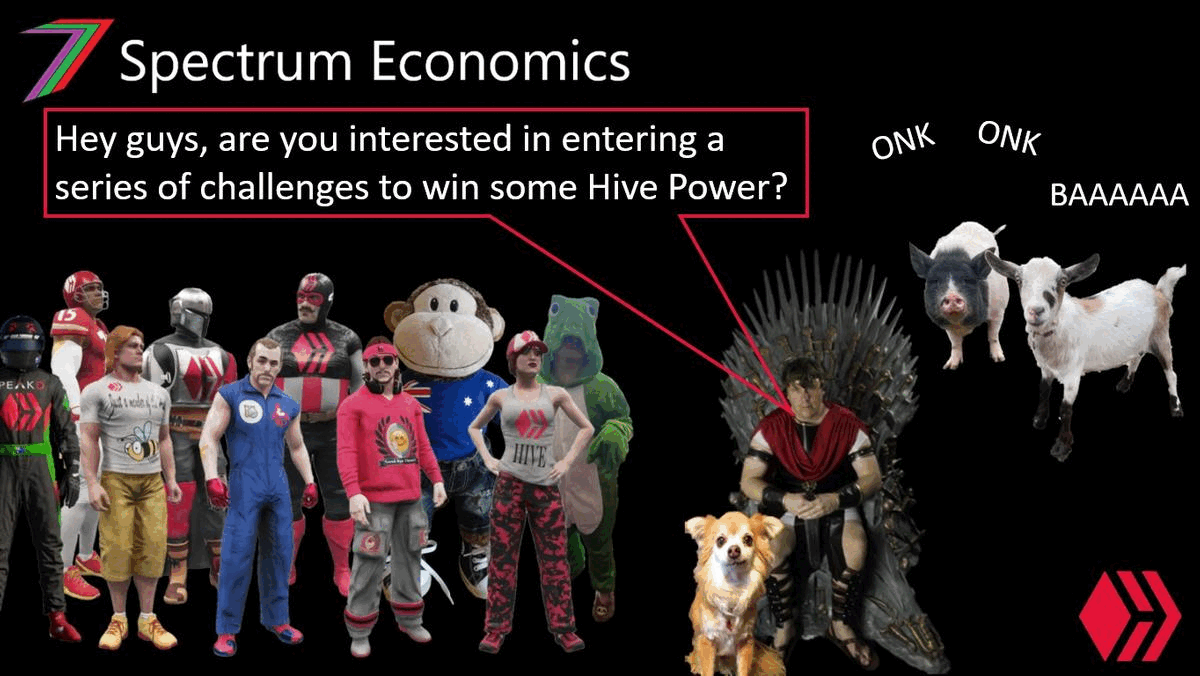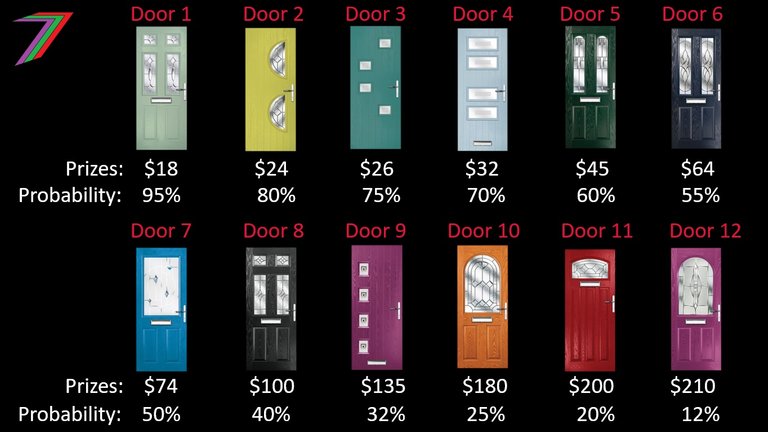Hi Everyone,

Welcome to the Economics Challenge Series for 2023. For the months of July and August, I am running an economics challenge series. The series consists of seven challenges. All seven challenges will commence in July and the results will be published and announced in August. Four of the seven challenges are returning from last year’s Challenge Series. Two are from the monthly contest series and one challenge is completely new. Below are the list of challenges.
- Challenge 1: Buying and Selling Game
- Challenge 2: Pick-a-Door
- Challenge 3: Complements and Substitutes
- Challenge 4: Buying and Selling Game (Business Version)
- Challenge 5: Ice Cream Game
- Challenge 6: Game Theory Game
- Challenge 7: Even-to-Win
Each challenge could reward winners with as much as 60 Hive Power. The value of the prize will depend on the level of participation. For each new participant, the prize will increase by 5 Hive Power. This will continue until 60 Hive Power is reached (12 participants). The first 12 participants will also receive a 50% upvote from this account. In addition to the prize money, the top few participants will be given points. These points will be used to determine the overall challenge series winner. This winner may receive as much as 80 Hive Power. The value of the prize will equal the sum of the number of participants across all challenges. This will continue until 80 Hive Power is reached.

For more information on the challenge series and the upcoming challenges, I recommend that you read my post Economics Challenge Series 2023 (Coming Soon).
Welcome to Challenge 2: Pick-a-door
How to Play?
In this challenge, participants are required to make decisions based on expected payoff and risk. Participants are presented with 12 doors. Behind each door there could be a prize (expressed in dollars). Each door has a possible prize worth a different amount. As the value increases the probability of the prize being behind the door decreases. For example, Door 3 might have an 85% chance of a prize worth $30 and Door 7 might have a 30% chance of a prize worth $100. If the prize is not there, the participant will receive a value of zero.
Opening a door incurs a cost, each participant is given a budget of $60. Therefore, each participant can only open as many doors as their budget permits. Participants are not compelled to use all of the budget. If a participant opens 2 or more doors that have zero value behind them, they are eliminated from the challenge. If not eliminated, the winner is the participant with the highest total value expressed in dollars (i.e. combined value of prizes minus cost of opening doors). The winner will receive 2/3 of the prize and second place will receive 1/3 of the prize.
All entries must be made in the comments section of this post.
Each account is only permitted one entry.
Objectives of the game
The objective of the game is to obtain the highest prize value minus costs without opening more than one door that has a value of zero. The participant who can do this will be the winner.
Game Assumptions
- The value revealed behind each door is what each participant who selected that door wins. There is no sharing of prizes in this challenge.
- All doors cost the same amount to open ($15 for this challenge). Not opening a door has a zero cost.
- If it is revealed the door does not have a prize behind it, the value is zero and the fee required to open the door is lost.
- Based on the budget allocated and the cost of opening each door, each participant can only open a maximum of 4 doors. However, the participant may choose to open less.
- If a participant opens more than one door that does not have a prize, he or she is eliminated from the challenge regardless of the value accumulated from the doors that have prizes behind them.
- The order that the doors are opened does not affect the probability of a prize being behind it.
What information is provided?
- All possible prize values behind each door are provided.
- All probabilities that these prizes will eventuate are provided.
- Cost of opening doors is provided.
How are the results of the game determined?
A Microsoft Excel Model is used to determine if the prizes are behind the doors. The model will calculate each participant’s winnings as well as determine the overall winner. The results post will contain a video of the model generating all relevant values. The winner will be announced in both the video and the written post.
Contest Prizes
The total prize for this challenge could reach as high as 60 Hive Power. The number of participants determines the value of the prize. For every entry, the prize is increased by 5 Hive Power until a value of 60 Hive Power is reached. The winner will receive 2/3 of the prize and second place will receive 1/3. The first 12 entries will be given upvotes. The winner of this challenge will be given 30 points, second place 15 points, and third place 5 points. These points will be tallied at the end of the challenge series to determine the overall winner.
Let the challenge begin
Participants can choose to open up to 4 of 12 doors for a chance to win prizes valued in dollars. Figure 1 contains the twelve doors, the value of the prizes that might be behind them, and the probability this will occur.
Figure 1: Value of prizes and probability

The cost of opening each and any door is $15. The fee is deducted from the value won to determine the overall value gained
Entry format
For this challenge, I expect to see entries made in the following format:
Doors Opened:
Door: W
Door: X
Door: Y
Door: Z
Example of entry
Doors Opened:
Door 1
Door 6
Door 7
Door 9
The closing date and time for this challenge is 6PM coordinated universal time (UTC) 16/07/2023. Responses after this time will not be accepted. The winners will be announced in the results post along with the video containing the generation of values for each item.
I hope everyone has fun and enjoys the second challenge. I look forward to your participation in the remaining challenges. If you have any questions, feel free to ask in the comments section.
More posts

I have several collection of posts. I have organised these collections based on content and purpose.
The first collection contains six collection posts created before PeakD had the collection feature. Four of these posts relate to the core of my content, one of them contains all my Actifit Posts, and one of the them contains my video course ‘Economics is Everyone’.

The second collection consists of the posts that I consider define my channel. These posts are significant in terms of content as well as how they contribute to the growth of the channel. These posts reveal the most about what I believe in.

The third and fourth collection is what I call my ‘Freedom-base Economics living book’. They contain all the posts that support my ideas about the value and power of freedom. Some of these posts explain what we can achieve with freedom and what we need to utilise it. Some of them explain how we are deprived of freedom and how we often give up freedom for security and comfort. The third collection concludes with possible scenarios depending on what we (society) choose to do.


Hive: Future of Social Media

Spectrumecons on the Hive blockchain



